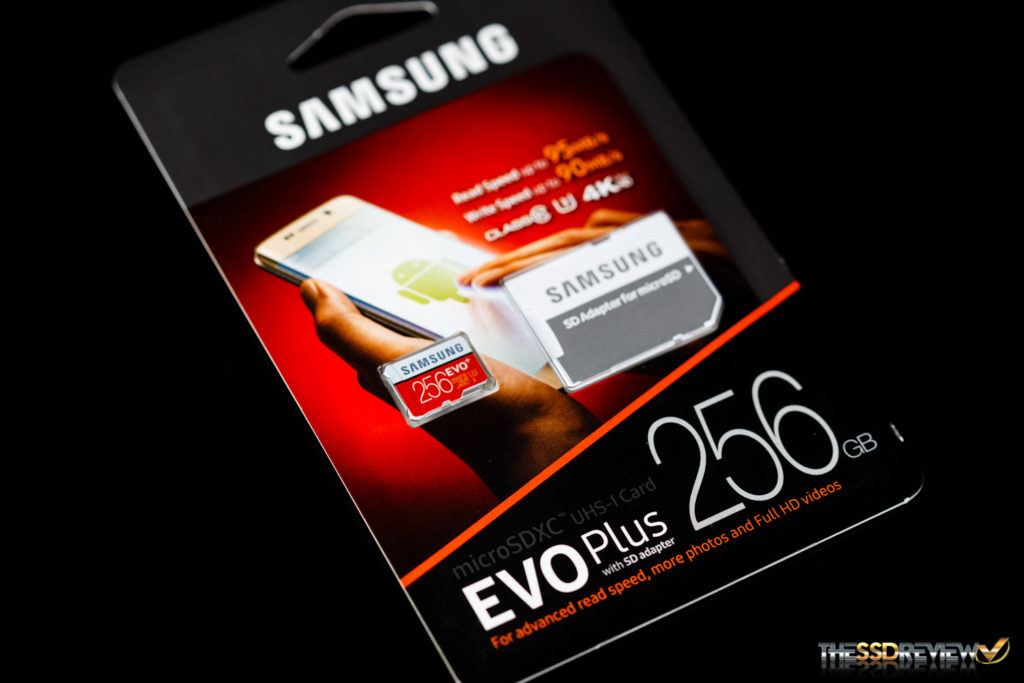Released earlier last year, the Samsung EVO Plus line of microSD cards has been quite a success. In light of this, Samsung has decided to continue the momentum and push boundaries by expanding the capacity availability. Today, Samsung has released the world’s largest microSD card, and in order to do so, they have integrated their latest 48-layer TLC V-NAND into it! At 256GB, it is more capacity than some laptops and now you can have this kind of capacity on your phone or tablet, action cam, or any device that accepts microSDXC cards!

PACKAGING, SPECIFICATIONS, AND DESIGN
The Samsung EVO Plus microSDXC cards are available in capacities from 16GB to now 256GB with prices starting as low as $12 for the 32GB model. The 64GB and 128GB models are also very competitively priced at about $20 and $39 respectively. The MSRP of the 256GB model we are reviewing today is $250, but we think street prices should follow similar trends to that of the other capacities soon.

Shipped out in a very stylish blister packaging, the Samsung EVO Plus comes with an SD adapter as well. From the packaging, we can see that it is a Class 10 U3 rated product, which means it has been designed for 4K video capture in mind. Read and write speeds are well above its U3 rating at 95MB/s read and 90MB/s write. This is a nice step up in performance over the 128GB model which only provided for 80MB/s read and 20MB/s write.
The card styling is quite appealing with the white and orange two-tone. On the front is the listed capacity of 256GB, when formatted it has 238GB of usable space. This card is waterproof (IEC 60529, IPX7), magnet proof, temperature proof from -25°C to 85°C, and x-ray proof. It is rated for up to 10,000 mating cycles and comes with a 10-year warranty. It is also compliant with all SD Association specifications and compatible with microSDHC and microSDXC devices.Let’s move on and take a look at performance…
FLASH MEDIA TEST PROTOCOL
In order to test the rated speeds of the card, we choose to use a few popular synthetic benchmarks which include ATTO, CrystalDiskMark, and Anvil Storage Utilities Professional. Then, we are going to do a real-world file transfer of both photo and video files to demonstrate its performance as well. This should give us enough to confirm the rated specs and give us a more in-depth view of how it performs.
To connect the microSDXC card to our computer we have the Kingston MobileLite G3 USB 3.0 card reader. It is a compact and simple plug-and-play card reader that allows for USB 3.0 transfer speeds for any SD / SDHC / SDXC and microSD / SDHC / SDXC cards. It is a pretty good buy especially at only around $10 and will allow us to test the flash card at up to its max rated speeds.
ATTO DISK BENCHMARK VER.3.05
ATTO Disk Benchmark is a relatively easy-to-use benchmark tool. ATTO Disk Benchmark relies on testing different file sizes with highly compressible data. Although this is not the best representation of media files which are, for the most part, highly incompressible, it is a good start and is still the main mechanism most manufacturers use to determine their product specifications. In our testing, we have left the benchmark settings to default.

Initial ATTO results show reads above 98MB/s and write speeds writes of nearly 90MB/s. Continue to the next page for the rest of our benchmarks and our final thoughts.
 The SSD Review The Worlds Dedicated SSD Education and Review Resource |
The SSD Review The Worlds Dedicated SSD Education and Review Resource | 
This is a welcome product for folks who have servers that accept SDs. Very popular with Dell VMware servers.
I just have this great big feeling that performance is being artificially constrained with these products.
And by that you mean…..
Hello,
It is absolutely a good SD card choice. Honestly, I did have used the related SD memory card for several years inside my mobile phone, however, recently one of my 64GB Toshiba SD card was corrupted and kept asking to format. Even though I did have formatted this card data to restore its common use by following this article, https://www.icare-recovery.com/howto/sd-card.html , I was still wondering whether it was necessary to change a new one for future use. So, I purchased one and hope it will not be too bad.